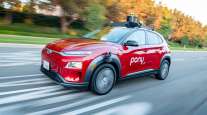Uber Partners With Revel to Expand Charging Network

[Stay on top of transportation news: Get TTNews in your inbox.]
Uber Technologies Inc. struck a partnership with electric vehicle ride-hailing startup Revel Transit Inc. to make charging stations in New York more accessible as it inches toward a goal to make all trips zero-emission by 2030.
Uber’s sustainability efforts align with proposed rules by New York City and the Taxi & Limousine Commission that would require the company, along with Lyft Inc. and other operators, to include only zero-emission or wheelchair-accessible vehicles in their fleets in six years, as part of a fight to improve air quality.
For Revel, the deal — which sets out usage guarantees by Uber drivers at its charging stations — will serve as a blueprint to accelerate expansion plans in other major U.S. markets like San Francisco, Los Angeles, Chicago and Boston.
It will also help increase options in New York neighborhoods where charging facilities are lacking, such as the Bronx and Queens. The Brooklyn, N.Y.-based startup is seeking to raise $200 million to build out its charging infrastructure and aims to be profitable in the fourth quarter.
We're excited to be one of the first participants in this new program from @ConEdison, designed to make NYC's grid stronger and get more fleets electrified. https://t.co/5zIlh17NBa — Revel (@_GoRevel) February 15, 2024
“There is intent for both parties to use this as a framework and bring that to other large ride-share markets,” said Revel co-founder and CEO Frank Reig. The company has a pipeline of more than 500 charging stalls under construction in New York and the San Francisco area through 2025, including 48 public fast chargers adjacent to the for-hire vehicle waiting area at LaGuardia Airport.
Revel currently operates 54 fast-charging stations at three hubs in boroughs outside of Manhattan, where most ride-share drivers reside and complete trips. It will begin offering exclusive discounts of as much as 25% for Uber drivers in the coming weeks as part of the deal. A charging session generally costs less than $20, according to Revel.

Uber’s sustainability efforts align with proposed rules in New York that would require the company to include only zero-emission or wheelchair-accessible vehicles in their fleets in six years. (David Paul Morris/Bloomberg News)
In the third quarter of 2023, only 6.5% of all miles traveled on Uber in North America were completed in electric vehicles, according to the company. In California it was more than 10% and 20% in London. Uber doesn’t disclose its progress in New York City, but the Taxi & Limousine Commission, which licenses for-hire vehicles, said more than 15% of trips are zero-emission or wheelchair accessible. New York quadrupled the number of EV taxi and rideshare licenses it has granted to about 10,000 after it lifted a cap on new permits last October.
In order to meet its 2030 goal, Uber needs to get its 6.8 million drivers and couriers to switch from fossil fuel vehicles to owning or renting an EV. Drivers are sometimes hesitant to make the change due to uncertainty about the availability of convenient, fast-charging slots and long charging times that would eat into hours when drivers could be working.
Uber has offered incentives, such as higher earnings for EV trips or up to $2,000 for new purchases of Teslas, if drivers complete 100 Uber rides on the new vehicle. In the past year, it has also helped inform city governments and energy companies of where demand for infrastructure is needed most.
Want more news? Listen to today's daily briefing above or go here for more info
In the future, as more ride-share fleets, rental car operators and EV manufacturers look to upgrade or resell their vehicles, Uber wants to set up partnerships to ensure supply can be available for its drivers in an affordable manner, Andrew Macdonald, Uber’s senior vice president of mobility and business operations, said in an interview.
“For most of the last five years, EVs have been priced at a significant premium to their internal combustion engine counterparts,” Macdonald said. “That dynamic is flipping and that’s going to be incredibly powerful.” He said Uber’s “big focus beyond charging infrastructure will be on making the economics work for drivers.”




